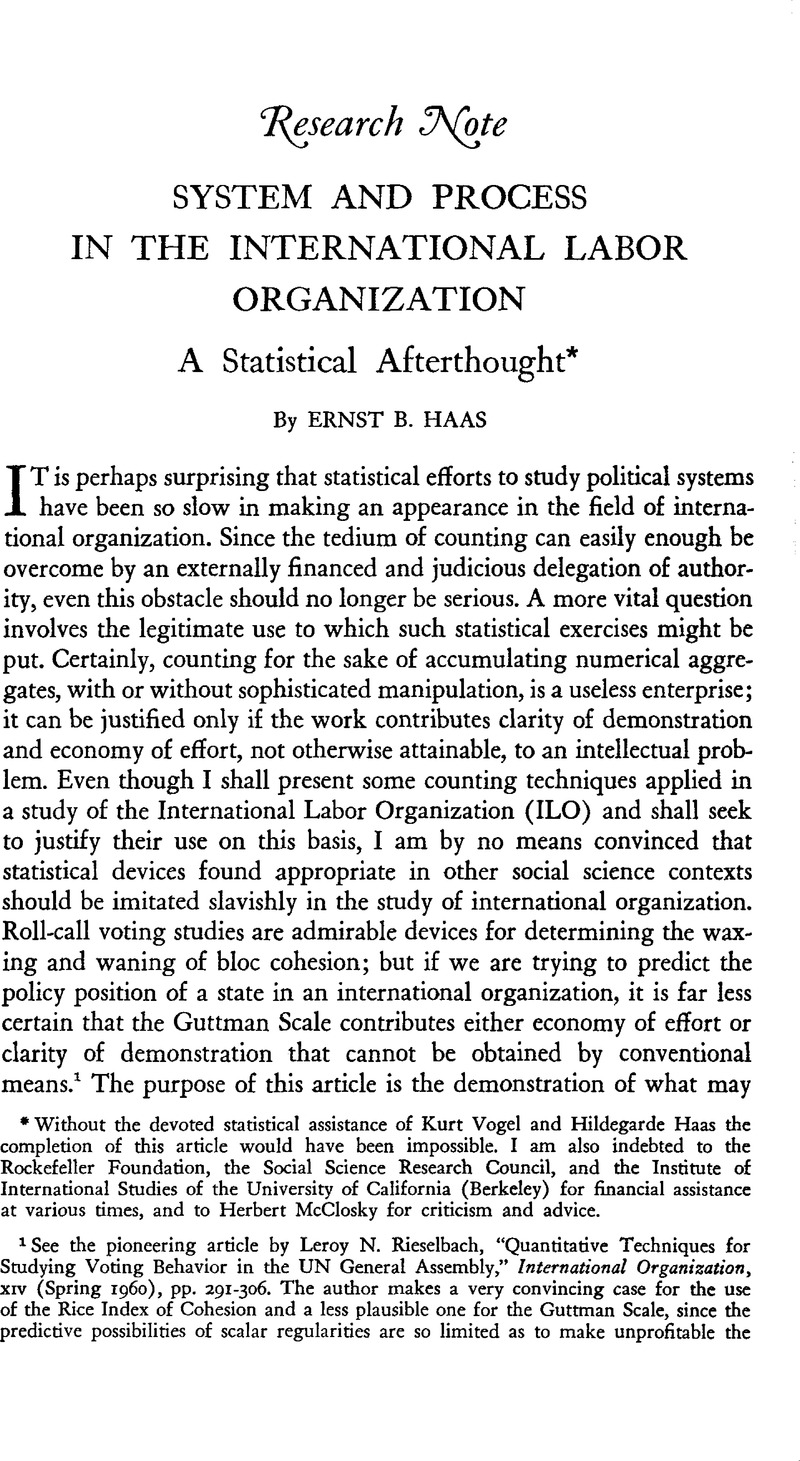Published online by Cambridge University Press: 18 July 2011

1 See the pioneering article by Rieselbach, Leroy N., “Quantitative Techniques for Studying Voting Behavior in the UN General Assembly,” International Organization, XIV (Spring 1960), pp. 291–306.CrossRefGoogle Scholar The author makes a very convincing case for the use of the Rice Index of Cohesion and a less plausible one for the Guttman Scale, since the predictive possibilities of scalar regularities are so limited as to make unprofitable the burden of establishing them. For other applications of a modified Rice Scale, see my Consensus Formation in the Council of Europe, Berkeley, Calif., 1960; and Haas, Ernst B. and Merkl, Peter H., “Parliamentarians Against Ministers: The Case of WEU,” International Organization, XIV (Winter 1960), pp. 37–59.CrossRefGoogle Scholar
2 See Easton, David, “An Approach to the Analysis of Political Systems,” World Politics, IX (April 1957), pp. 383–400CrossRefGoogle Scholar; McClelland, Charles, “Systems and History in International Relations: Some Perspectives for Empirical Research and Theory,” General Systems Yearbook, in (1958), pp. 222–34Google Scholar; and McClelland, “The Function of Theory in International Relations,” mimeographed paper prepared for the Symposium on the Place of Theory in the Conduct and Study of International Relations, University of Michigan, Ann Arbor, May 1960.
3 As cited in Almond, Gabriel A. and Coleman, James S. (eds.), The Politics of the Developing Areas, Princeton, N.J., 1960, pp. 53–54.Google Scholar Shils's categories are applied to the classification of some fifty new nations by Coleman in ibid., pp. 561–76. The apologies and caveats accompanying the classification convinced me that a less ambitious scheme which focuses on immediate structural features to the detriment of declared policy objectives is preferable for spelling out the environment of international organizations. However, in the devising of typologies, the necessity for distinguishing between structural elements, seen at a fixed point in time, and dynamic political motivations among elites by no means negates the desirability of classifying motivations. While it would be tempting to argue that a certain quantity of “inputs” into ILO, deriving from strong social welfare and modernizing commitments on the part of political elites, results in an “output” of a specific type of international convention, the history of ILO and the record of the members in ratifying conventions fail to establish such a connection. See my subsequent discussion of “coverage.”
4 The Stages of Economic Growth: A Non-Communist Manifesto, Cambridge, Eng., 1960.
5 Deutsch, Karl W., “Toward an Inventory of Basic Trends and Patterns in Comparative and International Politics,” American Political Science Review, LIV (March 1960), esp. pp. 40–44.Google Scholar Measurement profile statistics for African, Asian, and Latin American countries can be found in Almond, and Coleman, , eds., op.cit., pp. 579–82.Google Scholar
6 Deutsch, , op.cit., p. 35.Google Scholar
7 Almond and Coleman, eds., op.cit., concluding chapter entitled “The Political Systems of the Developing Areas,” especially pp. 532–44.
8 Lipset, Seymour M., “Some Social Requisites of Democracy: Economic Development and Political Legitimacy,” American Political Science Review, LIII (March 1959), pp. 69–105.CrossRefGoogle Scholar
9 International Labour Office, International Labour Standards, Geneva, 1960, pp. 12–13.Google Scholar
10 International Labour Office, Lasting Peace the ILO Way, Geneva, 1951, pp. 60–62.Google Scholar
11 For an elaboration of this argument and other statistical means for dealing with it, see Deutsch, , op.cit., pp. 46–48.Google Scholar
12 See Riggs, Robert E., Politics in the United Nations, Urbana, Ill., 1958Google Scholar; Hovet, Thomas Jr, Bloc Politics in the United Nations, Cambridge, Mass., 1960.CrossRefGoogle Scholar
13 For the most complete statement of the functional argument, see Mitrany, David, A Working Peace System, London, Royal Institute of International Affairs, 1943.Google Scholar For a succinct summary and critique of Mitrany's assumptions, see Claude, Inis L. Jr, Swords into Plowshares, New York, 1959Google Scholar, ch. 16.
14 For an exhaustive and balanced evaluation of the consequences of the Soviet return to the ILO, see Jacobson, Harold K., “The USSR and ILO,” International Organization, XIV (Summer 1960), pp. 402–28.CrossRefGoogle Scholar
15 The same 416 roll-call votes that were used as our data thus far were broken down as follows in terms of specific issues:
International Labor Conventions 177 votes (Tables 8, 9, 10)
International Labor Recommendations 78 votes (Tables 11 , 12, 13)
Agenda 49 votes (Tables 14, 15, 16)
Credentials of Delegates to International Labor Conference 48 votes (Tables 17, 18, 19)
Others 64 votes (not computed separately)